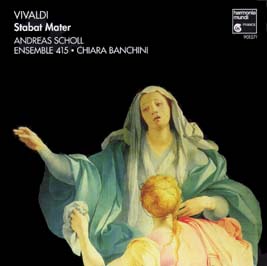There is hefty and wonderful choice of baroque music available on CD today. The CD suggested herebelow is
indeed personal one. However all recordings being recommended henceforth will give you more transparent and deep impression,
because most of them are well recorded and have high performance. Having enjoy baroque sound makes you feel more cozy than ever.
This is first one I recommend. I slate to update recommendable recording monthly basis

I'm the opinion of that the most beautiful and profoundly perfect instrument of
all is nothing but human voice. This is the main reason why I recommend Stabat Mater composed by Antonio Vivaldi.
for alto, string and basso continuo RV 621
Harmonia Mundi - HMU 90157 (CD)
Concerto ripiento C major RV114
- Allegro (2:27)
- Adagio (0:43)
- Ciaccona (3:01)
Cantate " Cessate, omai cessate" RV 684
- Largo e sciolto. Cessate, omai cessate (1:58)
- Largetto & Andante molto. Ah ch'infelice sempre (5:17)
- Andante. A voi dunque ricorro orridi specchi (1:14)
- Allegro. Nell'orrido albergo ricetto di pene (3:35)
Sonata a quatro "Al Santo Sepolcro" RV130
- Largo molto (2:22)
- Allegro ma poco andante (2:41)
Introduzione al miserere "Filiae Maestae Jerusalem" RV638
- Recitativo. Adagio. Filiae maestae Jerusalem (1:54)
- Largo. Sileant zephyri (6:37)
- Recitativo. Sed tenebri diffusis (0:58)
Statbat Mater RV621
- Stabat Mater dolorosa. Largo (2:53)
- Cujus animam gemetem. Adagio (1:47)
- O quam tristis. Andante (1:50)
- Qui est homo. Largo (2:48)
- Qui non posset. Adagio (2:03)
- Pro peccatis suae gentis. Andante (1:49)
- Eja mater, fons amoris. Largo (2:44)
- Fac ut ardeat. Lento (1:39)
- Amen. Allegro (1:04)
(TOTAL TIME 52:02)
Andreas Scholl, conter tenor
Ensemble 415, Chiara Banchini

Until large quantities of sacred vocal music originating from his personal archive unexpectedly came to light in the late 1920s,
few peole took seriously as a particioant in this branch of activity. Only two or three works of this kind were
known to survive from his pen; he had never been made maestro di cappella of nay institution;
his penchant for exhibitionism in his sonatas and concertos seemed at variance with ecclesiastical sobriety; and
his bad reputation within the church (as a priest who no longer said Mass and was reputed to cohabit with opera singer)
hinted at disaffection with religion itself.
All these negative factors were in time shown to be misconceptions oroversimplifications.
It is true that rather little of Vivaldi's church music propagate outside Venice during his lifetime,
but its acceptance into the repertoires of churches in cities as distant as Dresden and Plague
proved that in somequarters, at least, its standing was high. Despite never himself a maestro di cappella
- it was singers or keyboard plaers rather than violinists who were normally named for such role.
Vivaldi play a main role to supply sacred vocal composition to the Ospedale della Pieta
The Venetian institution for foundlings that he also worked as director of instrumental music) from
1713 through 1718, during the absence on leave of the official choirmaster. Subsequently his reputation
take him into many commissions from churches not only inside Venice but also it's outside. and Pieta
Request him for his services again during at least one later interregnum between choirmasters in 1739.
He turned the exuberance of his sacred vocal works, helping to lay the foundations of the "symphonic"
style that we admire so much in the Masses of Hydn and Mozart.
Eventually new biographical discoveries established that Vivaldi, even if certainly not of saintly character,
was devoted almost to the point of obsession to his religious belief. The main reason why he refused to say Mass
was due to not laziness or indifference but his asthma.
Of his 50-odd surviving sacred vocal compositions, which include sections of the Mass, psalms, antiphons,
hymns and solo motets, the Stabat Mater RV 621 is the earliest to which we can assume a date.
It was written as a hymn to be sung at the feast of the Seven Sorrows of the Blessed Virgin Mary on 18 March 1712
at the church of the Oratorian Order in Brescia. Vivaldi's other hymns are all strictly strophic; the Stabat Mater conforms
to this pattern only to the extent of retexting movements 1-3 to make nos. 4-6. Movements 7 and 8, and also the concluding
"Amen" in fugal style, are completely independent. Throughout this powerful work the composer maintains a gloomy,
claustrophobic atmosphere entirely in keeping with the sorrowful spirit of the text. The radiant major chord ending the
"Amen" offers a final, consolatory glimpse of Paradise.
Andreas Scholl began his musical training as a member of the Kiedriche Chorbuben, a boys's choir with a 650
year-old choral tradition.
From 1987 to 1993 he was a pupil of Richard Levitt and rene Jacobs at the Schola Cantorum Basiliensis(Diploma in Early Music).
He had already popped up in numerous concerts and on a good number of recordings. Andreas Scholl has been engaged to appear in the
Festivals of Versailles, Ambronay, Saintes and Munich. In 1992 he was awarded the prizeds of the Council of Europe and of the Foundation
Claude Nicolas Ledoux.
In addition he is a prizewinner of the Ernst Goehner Foundation and of the Migros Association.

Turn to Main Page
